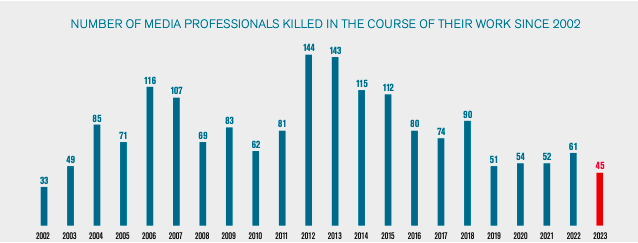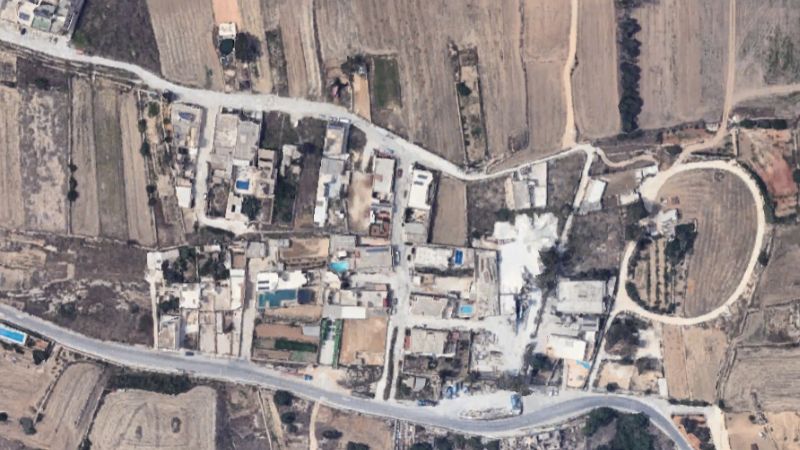The number of journalists killed in connection with their work is declining, reaching the lowest figures since 2022 this year, despite the conflict in the Middle East.
The most recent report by Reporters Without Borders (RSF) states that in 2023, a total of 45 journalists were killed while performing their duties, which is 16 less than the previous year (61). This is the lowest number of casualties since 2002, when 33 were recorded.
In terms of the worst year on record, between 2012 and 2013, over 140 journalists were killed, primarily due to the wars in Syria and Iraq.
In Gaza, up until 1 December, at least 13 journalists were killed because of their work, a figure that rises to 56, including all journalists killed in the Gaza Strip, whether or not in the line of their work.
Meanwhile, preliminary investigations by The Committee to Protect Journalists (CPJ) showed at least 63 journalists and media workers were killed in Gaza as of 14 December, with the number likely to change as investigations proceed.
Decrease in violence
The decrease in violence against journalists can be partially attributed to the enhanced security measures taken to protect them, RSF said. Journalists are now better trained and equipped to handle dangerous situations in conflict areas.
Regulatory frameworks have been implemented in peaceful regions to ensure their safety and more robust mechanisms to combat impunity. However, in some places, journalists may be practising self-censorship due to increasing threats, which could contribute to lower exposure to physical risks.
In a statement, RSF’s Secretary General Christophe Deloire said that “on a global scale, it seems that the number of journalists killed in the course of their work or connection with their work is in sharp decline, over a long period. The reasons? Security measures at news organisations, training and allocation of protective equipment, caution, the effects of the fight against impunity and actions by inter-governmental organisations. The work of NGOs is undoubtedly also having an effect.”

Significant decline in journalists killed in 2023. Source: Reporters Without Borders (RSF)
The report also underscores that for the first time since 2018, the number of journalists killed in war zones was proportionally higher than the number killed in peaceful regions.
This year saw the death of 23 journalists during their reporting in war zones. Most of them (17) were killed in the war between Israel and Hamas, with the majority in Gaza.
The second most dangerous area for journalists is investigating organised crime and corruption, with 15 journalists killed in 2023 while reporting on these issues, particularly in Latin America and Africa.
Although the number of journalists killed in Latin America has dropped significantly, from 26 in 2022 to six in 2023, this region is still one of the most dangerous regions to work as a journalist, as recent abductions and armed attacks in Mexico demonstrate.
Moreover, Mexico continues to be the country with the most journalists listed as missing, accounting for 31 out of 84 missing media professionals.
There are still 521 journalists detained worldwide as Belarus becomes one of the three biggest jailers, joining China and Myanmar.
RSF also reported that at least 54 media professionals are currently being held hostage in Syria, Iraq, Yemen, Mexico, and Mali. Nearly half of these journalists (25) were kidnapped by the Islamic State (ISIS) in Iraq or Syria between 2013 and 2015.
RSF has published annual reports on violence and abuses against journalists since 1995. The report covers data gathered from 1st January to 1st December each year and includes professional journalists, non-professional journalists, and media workers.
RSF compiles detailed information to confirm with certainty or high confidence that the detention, abduction, disappearance, or death of each journalist was a direct result of their journalistic work.
The figures presented in the 2023 report are based on data compiled until 1st December 2023 and do not include any arrests, releases, deaths, or disappearances after that date. The latest figures are in RSF’s Press Freedom Index, which is regularly updated.
RSF’s full report and accompanying infographics can be found here.













